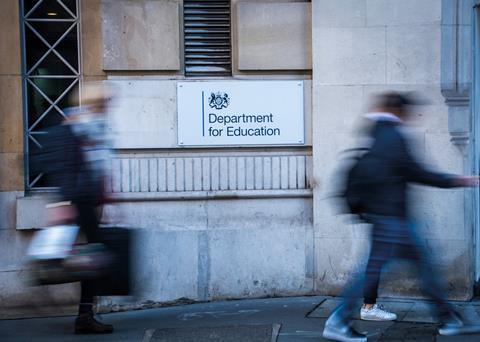Just 24 contracts awarded under programme to rebuild or refurbish 500 schools announced three years ago, NAO report finds
Nearly two in five school pupils in England are being taught in buildings that have passed their intended design life and the government is spending less than half the money it says is needed to keep them safe, a new report has found.
The study by the National Audit Office (NAO) also warned around 700,000 pupils are learning in schools that the responsible body or the Department of Education (DfE) believes requires major rebuilding or refurbishment.
Meanwhile, a separate NAO report found the DfE has no plan in place to achieve the 75% reduction in carbon emissions from public sector buildings the government has promised to achieve by 2037.

State primary and secondary schools and universities account for around 37% of public sector emissions in England but the NAO said the DfE’s current school rebuilding programme will “not bring it close” to hitting its emissions reduction target.
The NAO scrutinises public spending to help Parliament hold the government to account and is independent of both the government and the civil service.
The body’s Condition of School Buildings report found 38% of England’s 64,000 school buildings are now believed to have passed their estimated initial design life.
The government spent an average of £2.3bn each year between 2016-2017 and 2022-2023 of capital funding for school rebuilding, maintenance and repair, less than half of the £5.3bn recommended by the DfE in 2020 as a minimum requirement for maintaining schools in the long term.
This recommended funding would also encompass mitigations of the “most serious risks of building failure”, the NAO said, including those buildings which contain unsafe reinforced autoclaved aerated concrete (RAAC).
RAAC is a lightweight form of concrete mostly used in system build programmes between the 1960s and 1980s which has now passed its 30-year design life. The material is causing increasing concern across the public sector, with the government earlier this month ordering all departments to investigate their estates to identify where it may be present.
> Also read: Government orders all departments to investigate lightweight concrete risks
> Also read: Dozens of hospital building roofs at risk of imminent collapse, minister admits
Although the NAO said the DfE had made progress in the last year, it warned the department still “lacks comprehensive information” on the extent and the severity of safety issues which would allow it to develop a longer term mitigation plan.
Labour MP Meg Hillier, chair of the Public Accounts Committee, which reviews NAO reports, said the findings were “worrying”.
She said the DfE’s data gathering efforts had uncovered a “serious deficit in annual funding required to improve schools,” adding: “After years of firefighting issues, parents need reassurance that the department knows where, when and how any risks to their children will be remedied.”
In 2020 the government announced a 10-year programme to rebuild or refurbish 500 schools found to be in the most urgent need, with 400 already selected.
But the NAO found the government had awarded just 24 contracts as of March 2023, a third of the 83 contracts it had expected to have completed by this date, and only one project has been completed compared with a forecast of four.
Reasons given for the slow progress of the programme include education providers not taking up contracts given instability in the construction sector and inflationary risks, the NAO said.
And while new schools built or refurbished through the programme aim to achieve net zero emissions, these schemes will represent just 2% of the estate in England when complete.
The NAO said measures to reduce the carbon impact of the estate will not contribute to the government’s overall net zero goals unless they are rolled out “at a much larger scale, and relatively soon”.
“As it stands there is no plan in place for achieving the scale of decarbonisation across the education sector that is needed for DfE to make a proportionate contribution to government’s targets,” the body said in its separate Environmental Sustainability Overview.
The department is aiming to secure additional funding from the Treasury to test ways to reduce emissions from schools but does not yet have a clear view of the education sector’s current sustainability needs, what it will cost to decarbonise the estate and what interventions will offer the best value for money, according to the NAO.
The body recommended ministers work closely with the sector to share evidence of workable solutions and to encourage schools to use their capital and maintenance funds to make improvements in ways which will support the government’s net zero targets.



























No comments yet